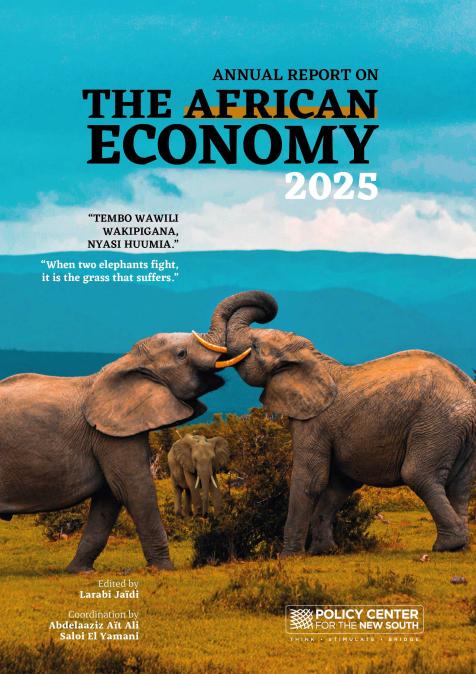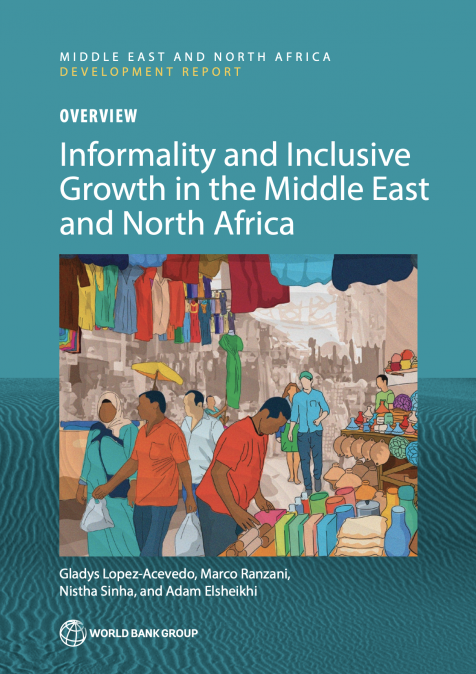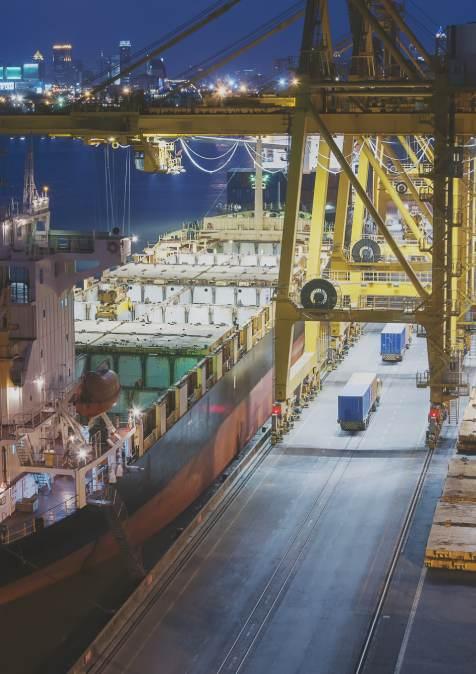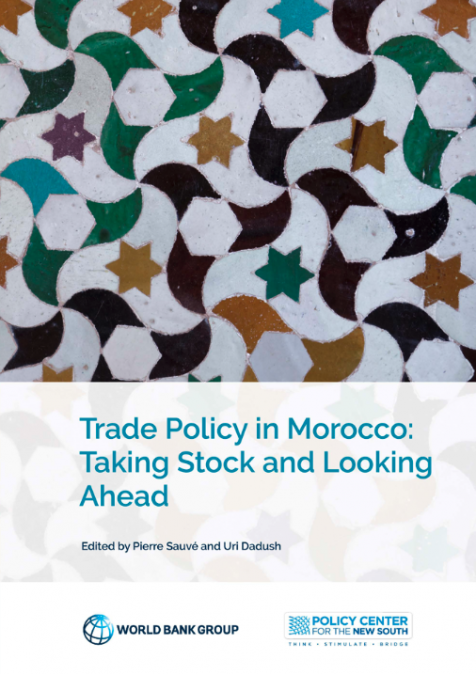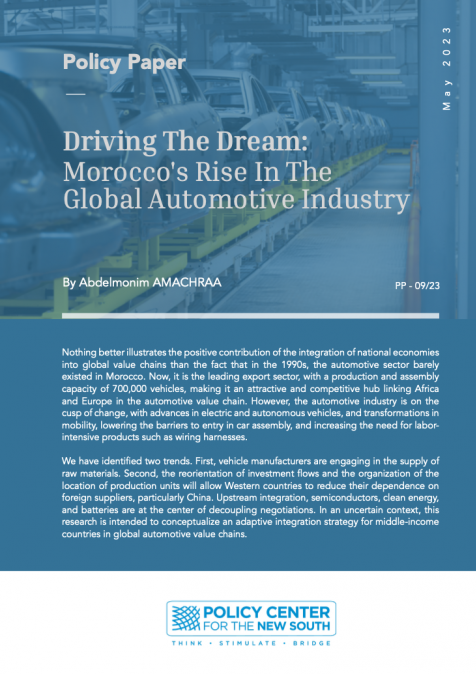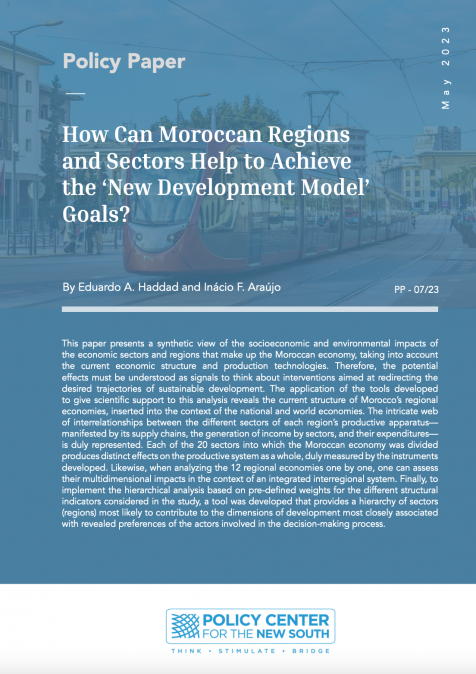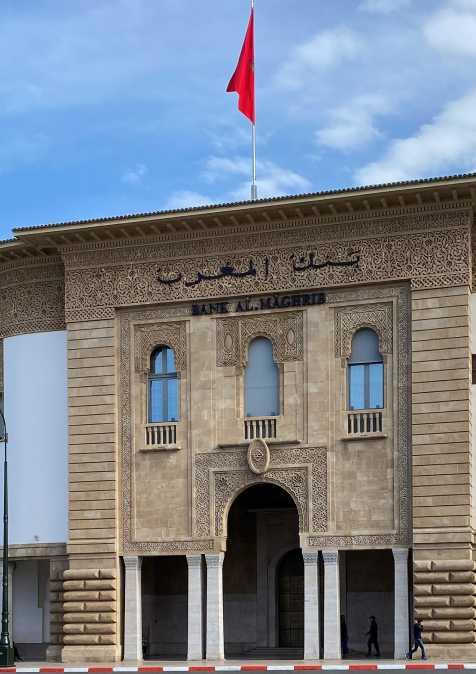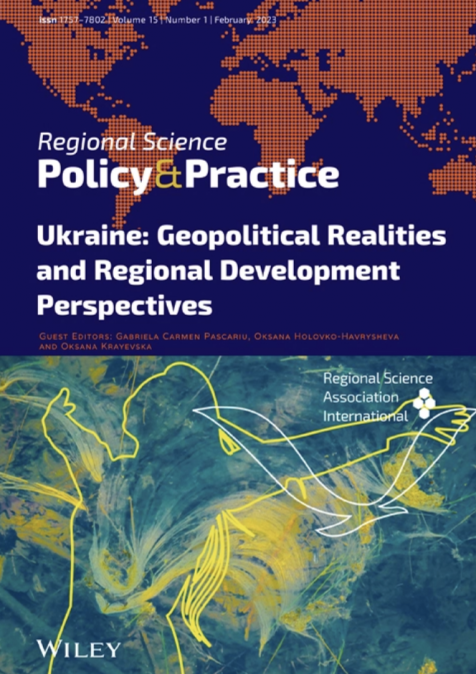Publications /
Annual Report
Book / Report
Available soon on livremoi.
The 2025 edition of the African Economic Report continues in the spirit of previous versions. It presents a broad overview of the continent’s economic evolution and offers insights into Africa’s relationship with the rest of the world. In other words, it explores how Africa navigates the effects of global fragmentation within its regional spaces while pursuing its ambition of continental integration.
The structure of the Report maintains the three foundational pillars of its original configuration: a first section that assesses macro- and meso-economic developments in Africa; a second section that examines changes or progress within the African Economic Communities; and a third section that focuses on key issues related to the implementation of the main protocols of the African Continental Free Trade Area (AfCFTA), including rules of origin, services liberalization, investment cooperation, competition policy, and public procurement management.
This new edition also introduces innovations within each of these three pillars, as well as in the presentation of new analytical and discussion sections.
Part 1 of the Report is dedicated to macroeconomic and financial issues, as well as sectoral transformations across the continent.
Africa’s macroeconomic performance presents a mixed picture across regions. Fully realizing the continent’s growth potential requires addressing major challenges, including managing deficits, diversifying economies, investing in human capital, and strengthening regional integration.
Each edition of the Report features a dedicated article on a specific African country. This year’s focus is Egypt. As one of the two largest economies on the continent, Egypt’s economic growth remains among the most dynamic in the MENA region. However, it is still insufficient to finance the rapidly growing public expenditures generated by mega-projects. In addition, regional geopolitical tensions raise concerns about the stability of an economy already under strain.
In an international environment increasingly concerned with financial instability, African countries are striving to influence discussions on reforming the global financial architecture to improve access to financing and promote sustainable development. Key questions raised by this evolving architecture are particularly relevant for Africa: sound public governance, the adoption of performance evaluation standards, the orderly liberalization of capital flows, exchange rate regimes, crisis prevention, and the reform of non- concessional lending facilities. These issues are crucial for the economic policymaking of African countries, whether concerning macroeconomic stability, increased investment, stronger financial systems, or greater transparency in public finances.
In addressing this topic, the authors offer insights on both medium- and long-term issues, as well as more immediate challenges. In the longer term, they examine the prerequisites for regional or continental single currency projects—still delayed but actively debated—and explore more feasible initiatives, such as Central Bank Digital Currencies launched by several African countries to enhance financial inclusion and build trust in financial transactions.
In the short term, the discussion focuses on African banks’ exposure to public debt, the importance of diversifying guarantee mechanisms to reduce lending risks to SMEs, and the benefits of harmonizing the liberalization of financial services to strengthen trade finance.
The analysis of African sectoral strategies centers on two domains with high potential for wealth creation: intangible capital, stemming from research and innovation in universities and training systems; and material capital, still largely untapped, such as the blue economy.
There is no doubt that African universities are shaping the next generation of leaders, innovators, and entrepreneurs. Contributions on this topic aim to compare the governance models of selected African universities, assess their ability to address challenges specific to the African context, and explore avenues for cooperation to build university alliances that contribute to a common African education and research space. Equally important is the exchange of experiences in professional training systems across the continent.
The blue economy holds vast potential for Africa. From fisheries and oil and gas to tourism, the possibilities are considerable. What we may call the “necessary ocean” for Africa’s future still includes many untapped areas—such as offshore energy and seabed resources. These are domains require a deeper understanding of resource potential to develop a resilient ocean space where ecosystems are preserved and resources are sustainably and jointly exploited.
In Part 2 on regional dynamics, we continue our annual tracking of the performance and challenges facing Africa’s Regional Economic Communities (RECs). While some RECs are making progress, others are stagnating, and in certain cases, economic momentum is hindered by political divisions. This phase also coincides with growing expectations for these RECs to converge within the broader framework of the AfCFTA. In light of these developments, we have revised the structure of this section: each edition now offers in- depth comparative analyses of one or two RECs, alongside reflections on the evolution of interregional cooperation across the continent and Africa’s relations with major and medium powers.
This edition focuses on the two most prominent RECs: the Economic Community of West African States (ECOWAS) and the Southern African Development Community (SADC). SADC has made significant progress in regional integration, particularly in trade and economic development. It has reduced tariff and non-tariff barriers, thereby promoting intra-regional trade. Nevertheless, challenges remain in harmonizing sectoral policies and regulations, implementing strategic plans that require acceleration, and progressing toward a single currency.
By contrast, the state of ECOWAS integration is less encouraging. While there has been modest progress in intra-regional trade and the free movement of people, major obstacles to integration persist—such as economic disparities, governance issues, and regional conflicts. The withdrawal of three member states is the most visible indicator of the bloc’s current crisis. The definitive departure of the three Sahelian countries presents new challenges for West Africa: restructuring ECOWAS and affirming the sovereignty and development autonomy of the Alliance of Sahel States (AES), particularly in managing their security and charting their development paths.
The strengthening of interregionality in key sectors is a powerful driver of economic integration. One prominent example is electrical interconnection, which involves linking national power grids across borders. This not only improves electricity access and grid reliability but also promotes trade among African countries and facilitates the integration of renewable energy sources into the continental energy mix—contributing to the fight against climate change. In the industrial sector, efforts to build regional value chains are still in their early stages. The example of the automotive industries in South Africa and Morocco demonstrates that strong national development dynamics can yield impressive results, but opportunities for complementarity and deeper cooperation still remain to be harnessed.
Interregionality can also be strengthened by forging links between a regional bloc and a leading country outside of it, or between two major economies from geographically distant regions. To illustrate this, we highlight two case studies. The first explores economic relations between Morocco and ECOWAS, where strengthening ties holds the potential to overcome shared challenges and lay the groundwork for a robust, mutually beneficial partnership that fosters economic development and regional cooperation across West Africa. The second focuses on the economic relationship between Nigeria and South Africa—two continental powerhouses where interactions are shaped by both cooperation and competition. Despite occasional tensions, their evolving partnership reveals a dynamic of collaboration that benefits not only the two countries but also the broader African continent.
While Africa patiently builds stronger links among its member states, it remains exposed to the influence of major global powers. Relations between the United States and Africa have long been complex and multidimensional, spanning economic, security, and development spheres. Today, the shifting geopolitical landscape and evolving U.S. foreign policy priorities prompt Africa to reassess the future of its partnership with a United States that is re- evaluating the foundations of its cooperation with developing countries. Meanwhile, China continues to be Africa’s leading trade partner, investing heavily in sectors such as infrastructure, energy, and mining. However, concerns are growing among African countries about trade imbalances and the environmental impacts of certain mining operations. As Sino-African relations evolve, there is increasing awareness across the continent of the need to address issues of debt sustainability, and to better defend African interests in this partnership.
The third part of the Report is devoted to the development of the AfCFTA. The contributions provide an overview of the implementation of trade liberalization measures and provide in-depth analyses of the Protocols that form the foundation of this ambitious agenda for deep integration and the establishment of a unified African market.
In terms of trade liberalization, 49 countries have submitted their tariff offers. Pilot exchanges conducted under the Guided Trade Initiative (GTI) provided an opportunity to assess the operational effectiveness of actual transactions. An adjustment fund is expected to support the financing of emerging regional value chains. Additionally, a digital platform—the African Trade Gateway—and the Pan-African Payment and Settlement System (PAPSS) are being developed to facilitate market access. However, the deepening of regional integration remains contingent on member states’ willingness to fully implement the adopted rules of origin, which are essential for determining eligibility for trade preferences.
The liberalization of services under the AfCFTA offers substantial opportunities but also presents challenges related to regulatory harmonization, which is necessary to ensure the fair and effective implementation of commitments. Moreover, it requires considerable investment in infrastructure—a complex and lengthy process whose success hinges on cooperation among member states, especially in areas such as trade facilitation, standardization, and regulatory alignment.
Beyond the initial protocols for liberalizing trade in goods and services, the dynamics of African integration are conditioned by the adoption and implementation of a set of additional Protocols. The Investment Protocol is expected to create a unique continental legal framework for investments, replacing existing bilateral agreements and promoting the simplification of investment procedures and the protection of investors’ rights. The Protocol on Labour Mobility, meanwhile, can ensure greater fluidity in the movement of skilled workers by allowing African workers to more easily seek employment opportunities. By fostering the sharing of skills and knowledge, it would contribute to the creation of a more integrated continental labor market. However, its implementation poses challenges, including the harmonization of labour mobility regulations and combating discrimination against migrant workers.
Furthermore, the Competition Policy Protocol aims to harmonize competition laws and approaches across the continent to combat restrictive business practices. The Public Procurement Protocol, meanwhile, seeks to establish a unified regulatory framework for public procurement, promoting transparency, fair competition, and greater participation by local businesses. By introducing common rules for procurement procedures across all member states, it would help foster equitable andhealthycompetitionamongcompanies operating within African markets.
In a context where local territories— despite differing levels of capacity— are increasingly becoming actors in development, the regulation and promotion of intra-African trade can no longer remain the sole prerogative of national governments. The AfCFTA offers a framework through which local governments can deepen the multiple dimensions of decentralized cooperation within the African space, particularly in cross-border regions.
This edition also includes a section dedicated to youth, whose voice we believe is essential for shaping the future of the continent. Their perspectives must be amplified to be more fully understood and debated—especially when they address forward-looking themes and propose innovation solutions for change. In an era where the digital revolution is reshaping the financial sector, a connected and enterprising generation is challenging traditional banking practices. For them, fintech represents more than convenience; it is a transformative tool offering rapid, dematerialized solutions that leverage new technologies to redefine how finance is conducted.
The Epilogue of this edition also introduces a new format. Unlike previous editions, we did not solicit the iconoclastic views of a non-economist on a major African economic issue. This year, we opted for a cross-perspective format in the form of a roundtable discussion on a highly topical subject: aid to Africa. Has aid failed in achieving its objectives? This is a complex and controversial issue that raises important questions about the effectiveness and long- term impact of aid. While aid can be essential in emergency situations, it is often criticized for its unintended consequences—such as inefficient resource allocation or fostering dependency.
The recent decision by the United States to end certain forms of bilateral aid or redefine its multilateral engagement frameworks calls for deeper reflection. What is the intent behind this shift, and what are the implications for Africa? Above all, it urges the continent to rethink how it can more effectively mobilize its own—both real or latent—resources and reform its public and private financing mechanisms.
This report concludes with statistical and thematic annexes. On the statistical side, rather than presenting extensive tables, this year we prioritized data visualization through charts, allowing the figures to speak for themselves. The annex on major economic events in Africa has also been streamlined for clarity, offering concise summaries of each event’s purpose and main takeaways.
Our thanks go to Boutaina Lmasrar and Fahd Azaroual, the authors of these annexes, for their valuable contributions.
This year’s Report has grown in both size and quality. With over 40 contributions, it addresses a wide array of topics, structured around interrelated themes that collectively deepen our understanding of complex issues. May the contributors from various regions of our continent and beyond find in this preface the gratitude of the Report Coordination Team for the quality and relevance of their analyses and adherence to the agreed scientific standards. Their full commitment and constant responsiveness made it possible to release the Report on schedule.
This rich and dense work could not have come to fruition without the full and continuous dedication of the scientific team, which oversaw its design, topic selection, editorial follow-up, and the identification of contributing authors. Special thanks go to Abdelaaziz Ait Ali and Saloi El Yamani for the tremendous amount of time devoted to both major and minor tasks required by this rigorous and meticulous undertaking.
We also extend our sincere thanks to the technical staff, particularly Mr. Mokhtar Ghailani and Mr. Youssef Ait ElKadi. Through their generous support and advice, they enhanced the normative and technical quality of this Report in both its design and presentation.
Larabi Jaïdi
Senior Fellow, Policy Center for the New South
Karim El Aynaoui
Executive President, Policy Center for the New South

